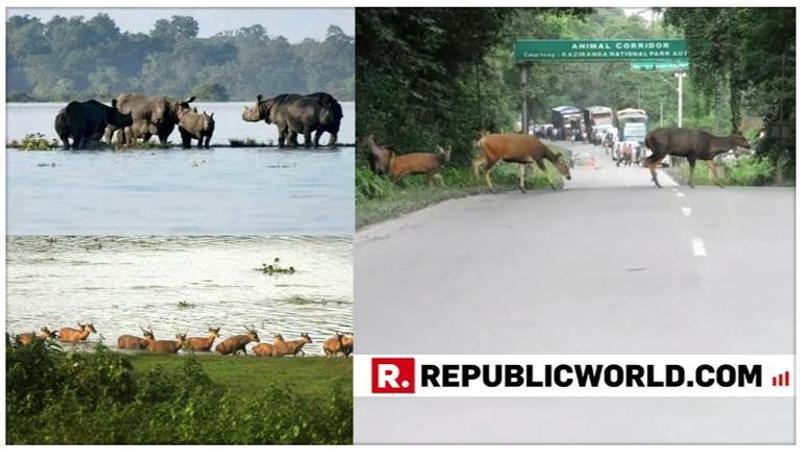Published 21:41 IST, July 16th 2019
Assam Floods: Wildlife affected at Kaziranga National Park; conservationists highlight threat of roadkills & poaching
The northeastern state of Assam has been ravaged by the incessant downpour, and along with bringing human life to a standstill has severely impacted the wildlife after 90% of the forestland of the Kaziranga National Park was submerged underwater.

Advertisement
The northeastern state of Assam has been ravaged by the incessant downpour, and along with bringing human life to a standstill, has severely affected the wildlife, with a large chunk of the forestland of the Kaziranga National Park submerged underwater.
Speaking to Republic World, Wildlife Conservation Trust president Anish Andheria opining on the calamity, accentuated on the need to provide 'permanent, wide, animal passages.'
He said, "Kaziranga is situated in the floodplains of the mighty Bramhaputra and hence it gets naturally inundated every year. However, when the landscape wasn't fragmented due to the National Highway; a battery of tea estates that are fenced; innumerable illegal quarries and above all, human habitations, animals would migrate to the highlands of Karbi Anglong as the floodwaters rose."
"In recent times, the rapid change in land use pattern around Kaziranga makes the movement of wild animals extremely challenging, resulting in disproportionately high number of deaths. The forest department tries it's best to rescue whatever animal they can, but they too are helpless in front of the anthropogenic pressures that have increased the wrath of the floods by a magnitude. The only solution to this man-made recurring issue is by making it mandatory for the tea estates to provide permanent, wide, animal passages; by ordering the highway authority to build underpasses at multiple places along NH-37, that are at least 500 meter wide and 7 meter tall and above all close down all illegal stone quarries along the migratory path of wild animals," he added.
Emphasising over the need for 'protection' rather than 'rescue', Tadoba Forest Official Anirudh Chaoji said that the poachers exploit such situations and that the state government and the state Forest Department is already alert over this situation.
He said, "Rescue is slightly difficult here. Wild animals capture – when they are getting washed off is a difficult task. Though motorboat rescue teams of the Forest Department are in place. It is not Rescue that is very important here. It is the protection that needs to be ensured when the animals leave the safety of the protected area and often reach close to the human habitation."
"Poaching is a reality of this area. And the unscrupulous poachers make use of the difficult situation that the animals are in. Forest Department and Government is alert to this fact and has mobilized staff to keep a watch for such elements. This includes the well-armed Assam Forest Protection Force," he added.
The wildlife conservationist further elaborated on three immediate efforts that need to be taken by the Forest Officials and noted that there is an imperative need to impose a speed limit on the highway, considering the displacement of animals.
The Forest official said:
1. The speed limit of the vehicles plying on the NH 37 – many animals are crossing the road. Not always only large animals that can be seen from a distance. The number of snakes and other smaller animals die – simply because they were not noticed in time."
2. Safety of the animals that leave the Protected Areas and come close to human settlements or rehabilitation sites," he added.
3. This is a very important case for making an elevated road. Kaziranga has a highway passing through it. A detailed study needs to be done of the maximum possibility of Crossing Zones and in such areas, the highway needs to be elevated. Kaziranga is a National Heritage. And the floods are an annual event. Also, animals tend to cross the highway even during non-flood times. Such an elevated road will help the cause.
With the prevailing situation far from normalcy, a video of a herd of deer wading through neck-deep waters and more such discomforting photographs of the wildlife on social media had laid bare the gravity of the situation.
According to Republic TV sources, no Tiger deaths have been reported as per the data, however, 2, rhinos, 3 elephants, along with 5 Hog Deers, and 1 Wild Boar have died due to drowning.
Meanwhile, 1 Sambar Deer and 8 Hog Deers died after being hit by vehicles amid the floods while moving towards the highlands. Along with the loss of animal lives, anti-poaching camps on the fringes of the forest have been affected, causing an alarming situation.
At the moment, Section 144 has been imposed around the Kaziranga National Part
Here are some distressing photographs from the floods:
As per the latest update, 30 out of 33 districts have submerged in the state. The worst affected areas are Lakhimpur, Majuli, Kaziranga, Morigaon, Barpeta and Nalbari. The death toll of people owing to the situation is 15. Over 50 lakh people have been affected because of the state. The government has set up over 183 relief camp for the people affected by the floods in the state. Over one lakh people are living in the relief camps currently.
19:51 IST, July 16th 2019







